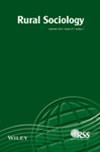美国非大都市和大都市人种多样性的不均衡增长和意想不到的驱动因素☆。
IF 2.3
3区 社会学
Q2 SOCIOLOGY
引用次数: 0
摘要
高度的人种多样性是美国大都市地区的一个决定性人口特征,但多样性在非大都市地区的作用往往未得到充分重视。在此,我们使用 2000 年至 2020 年的十年人口普查数据来评估非大都市县日益增长的人种多样性,并强调多样性在美国非大都市的不均衡地理分布及其变化。我们使用辛普森多样性指数衡量多样性水平,并描述人种构成的基本变化。然后,我们进行了反事实估算,以衡量七个人种群体的人口变化如何导致了多样性的变化,并比较了不同地理位置和人种群体对多样性的影响。我们发现,在过去二十年中,非大都市县的人种多样性增长了近 30%,但仍远远低于大都市县。重要的是,由于多种族和西班牙裔人口的增长以及白人人口绝对数量的减少,非大都市的多样性正在增加。在县级层面,白人人口和少数民族人口的多元化程度也大幅趋同。总体而言,非大都市多样性的增长受到多种复杂来源的驱动,并且在空间上具有异质性。鉴于人种变化对国家人口未来的核心作用,了解这些模式非常重要。本文章由计算机程序翻译,如有差异,请以英文原文为准。
Uneven Growth and Unexpected Drivers of Ethnoracial Diversity across Nonmetropolitan and Metropolitan America☆
High levels of ethnoracial diversity are a defining demographic characteristic of U.S. metropolitan areas, but the role of diversity in nonmetropolitan areas is often underappreciated. Here, we use Decennial Census data from 2000 to 2020 to evaluate growing ethnoracial diversity in nonmetropolitan counties and to highlight the uneven geographic distribution of diversity, and changes therein, across nonmetropolitan America. We measure levels of diversity using Simpson's Diversity Index and describe underlying changes in ethnoracial composition. We then produce counterfactual estimates to measure how population change among seven ethnoracial groups has contributed to changes in diversity and compare exposure to diversity across geography and ethnoracial groups. We find that ethnoracial diversity in nonmetropolitan counties has grown by nearly thirty percent in the past twenty years but has remained firmly below that of metropolitan counties. Importantly, nonmetropolitan diversity is increasing due to both growing multiracial and Hispanic populations and the decreasing absolute size of White populations. County‐level exposure to diversity among White populations and populations from minoritized ethnoracial groups has also converged substantially. Overall, growing nonmetropolitan diversity is driven by multiple complex sources and is spatially heterogeneous. Understanding these patterns is important given the centrality of ethnoracial change to the nation's demographic future.
求助全文
通过发布文献求助,成功后即可免费获取论文全文。
去求助
来源期刊

RURAL SOCIOLOGY
SOCIOLOGY-
CiteScore
4.60
自引率
13.00%
发文量
47
期刊介绍:
A forum for cutting-edge research, Rural Sociology explores sociological and interdisciplinary approaches to emerging social issues and new approaches to recurring social issues affecting rural people and places. The journal is particularly interested in advancing sociological theory and welcomes the use of a wide range of social science methodologies. Manuscripts that use a sociological perspective to address the effects of local and global systems on rural people and places, rural community revitalization, rural demographic changes, rural poverty, natural resource allocations, the environment, food and agricultural systems, and related topics from all regions of the world are welcome. Rural Sociology also accepts papers that significantly advance the measurement of key sociological concepts or provide well-documented critical analysis of one or more theories as these measures and analyses are related to rural sociology.
 求助内容:
求助内容: 应助结果提醒方式:
应助结果提醒方式:


